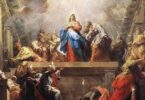6th Sunday of Ordinary Time
Scripture: Lev. 13:1-2, 44-46; Ps. 31:1-2, 5, 11; 1 Cor. 10:31-11:1; Mk. 1:40-45
Give, until it hurts, is the famous quote of St. Teresa of Calcutta. She used it in the national prayer breakfast in Washington, D.C on 3rd February 1994. She used this expression eight times in her speech. At the eight-time, she added two more words “with a smile”. Mother Teresa says that we need to give all that we have. It may be finances or services or resources, etc., until the point where we feel the pain of our sacrifice. It is very difficult for us to give until it hurts us. I saw in one of the interviews of Indian Cricketer Navjot Singh Siddhu who went to Mother Teresa in Calcutta to give his donation. She was cleaning the wounds of the lepers. He says that he was not able to sit there because of the stink from the wounds. He introduced himself to her and offered his remuneration of test cricket to her. Mother Teresa challenged him to his time as well to nurse the lepers. Mr. Siddhu narrates that he cried because he thought giving money was a great thing until the moment he realized he had no courage to clean the wounds of lepers.
Today’s liturgy challenges us to give until it hurts us. The first reading gives us an idea of leprosy. We have a reading from the Book of Exodus. The two entire chapters namely chapters. 13 and 14 deal with leprosy. The ancient near eastern texts attributed leprosy as a result of black magic or suffering of sins. There are many examples mentioned in the old testament. Miriam, the sister of Moses had a transitory illness of leprosy (Num. 12:10-15). Namaan, the leper also suffered and could not mix with people openly at the time of Elisha (2 Kings 5), four lepers were forced to live outside Samaria permanently (2 King 7:3-10) and King Uzziah was permanently quarantined in a separate room due to his skin disease (2 Chron. 26:19-21).
The priests played an important role like that of medical officers. They examined the leper and prescribed the mode of social treatment. If leprosy was suspected but not certain, a seven day quarantine was imposed on the person. If there was no further degeneration, then he was suggested another seven days of quarantine. In all this physical examination, the priests did not heal or contributed anything for healing. He performed rituals after the cure. It was the responsibility of the affected to pray and fast for healing. The priest did not even pray for them. Josephus, the historian who was a priest and lived during the time of the temple, in his description of the Mosaic laws, states that it was forbidden to the leper to come into the city at all to live with any others as if they were in effect, dead persons. (Jewish Virtual Library) In nutshell, we can summarize that the priest did not make any contribution to the lives of lepers.
In the Gospel, we hear about the healing of the leper. The leper approached Jesus with his pain. The state of the leper could be imagined. He was socially ostracized. He was not even given any help. He had no rights and privileges in his life. He was living a life worse than any animal. Unlike the priests who only physically examined the lepers, Jesus broke the Mosaic law on leprosy. Jesus made himself ritually unclean. Why would Jesus do it? Jesus shows that he identified himself with the leper. He allowed himself to be unclean so that the leper might become clean.
Once the person was healed, Jesus had sternly warned him to tell no one but he went about telling everyone about Jesus. As a result, the last verses of today’s Gospel tell us that Jesus could no longer go openly into any town, but had to stay outside in places where nobody lived. This is exactly what happened with the lepers. Jesus had to suffer like the lepers. He was forced to live where nobody could live.
Jesus cured the leper and sent him back into his family/community. Jesus gave everything that he had. He did not think about himself. He knew what would happen once the leper goes around after the healing. Yet, Jesus chose to heal him. He risked himself to be made unclean. Jesus gave until the moment it hurt him. It did it every time. He did it on the cross.
We are called to be like Jesus. We are called to give until it hurts us. St. Paul advises in the second reading not to do anything offensive to anyone. He tells us to be helpful to everyone at all times. He calls us to take him as a model, to imitate him. St. Paul gave all that he had to his faithful. He gave his life for Christ. Mother Teresa too gave her whole life to others. Both these saints imitated Christ. May we learn from Christ, Sts Paul and Teresa of Calcutta to give until it hurts us!






